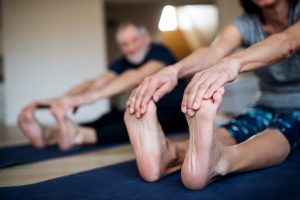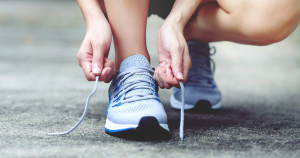Flat Feet – How to Treat This Common Foot Condition
 “Flat feet”, also known as fallen arches or pes planus, is a common foot deformity that affects the arch of the foot. As the medial longitudinal arch flattens over time or from an injury, the entire sole begins to touch the ground when standing.
“Flat feet”, also known as fallen arches or pes planus, is a common foot deformity that affects the arch of the foot. As the medial longitudinal arch flattens over time or from an injury, the entire sole begins to touch the ground when standing.
For some people, flat feet can be painless and require no treatment. For others, flat feet may cause foot pain, discomfort, and even other health problems such as plantar fasciitis or alignment issues and pain in the hips or knees. The arch of the foot absorbs shock as you walk and adds elasticity and flexibility. This creates a powerful lever to push off while walking.
Pain in this arch area can cause limitations with all daily activities. If you’ve been suffering from symptoms caused by flat feet, treatment may depend on the severity of the complications you are experiencing. Orthopaedic Hospital of Wisconsin physical therapist Gina Landry, PT, DPT, of Shorewood Physical Therapy, discusses a few treatment options for flat feet in the blog post below.
Exercise for Flat Feet

For individuals with mild to moderate arch pain, stretching and strengthening exercises can help to improve the foot of the ankle muscles and help to modify the pain by improving the weakened area. It is also important not to overstretch to cause additional damage to the feet. It is recommended that you consult a physical therapist for guidance on the most effective exercises for your individual needs.
A few examples of exercises for flat feet include:
- Calf Stretch: Stand facing the wall. Next, place your hands on the wall and step one foot backward, like a mini lunge position. Keep the back heel on the ground and the back knee straight to feel a stretch in the calf. Hold for 30 seconds and perform the stretch 3 times. Tightness in the calves exacerbates arch pain from flat feet.
- Towel Scrunches: Sit on a chair and place a towel under the toes of your foot. Then, use your toes to scrunch the towel and feel the muscles of your arch working. Perform 20 repetitions. This exercise works to improve the stability of your arch muscles.
- Big Toe Lifts: Sit on a chair with your feet flat on the floor. Focus on keeping the digits 2 through 5 on the ground and lift your big toe in the air. Repeat 10 times. This works on the stability of your arch muscles.
Flat Feet Shoe Orthotics
 If exercising alone does not correct the pain you’ve experienced from flat feet, arch support from shoe orthotics may be helpful. Orthotics are inserts for your shoes that lift your arch into a more optimal position. Orthotics can be purchased over the counter or they can be custom-made to fit your feet.
If exercising alone does not correct the pain you’ve experienced from flat feet, arch support from shoe orthotics may be helpful. Orthotics are inserts for your shoes that lift your arch into a more optimal position. Orthotics can be purchased over the counter or they can be custom-made to fit your feet.
Custom orthotics can be helpful if you have a long-standing history of foot pain. They can also help if you have biomechanical issues that affect how you walk or run. You do not need a prescription to get a pair of custom orthotics.
At Orthopaedic Hospital of Wisconsin, several physical therapists are certified to make custom orthotics to fit your needs. If you are interested in custom orthotics, a physical therapist will evaluate your foot structure and examine how your foot responds to basic movements. This can include walking or squatting. Then, a plaster mold of your foot is created. This mold is used to fabricate your custom orthotics.
Once you have orthotics, it is normal to have a “break-in” period, just as you would for a new pair of shoes. The arches of your feet need to adjust being in this new position. After a few weeks, you should notice an improvement in alignment and a decrease in pain.
To consult a physical therapist to help you resolve pain caused by flat feet, go online to make an appointment or call (414) 961-6800. Orthopaedic Hospital of Wisconsin physical therapy clinics are located throughout Southeast Wisconsin to help assist you with pain at your convenience.

